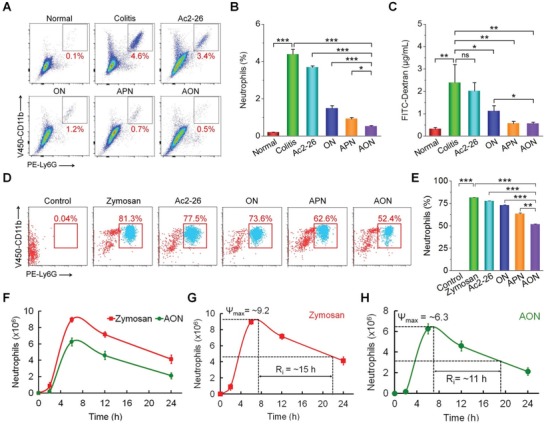Figure 9.

In vivo anti‐inflammation, epithelial wound healing, and resolving inflammation by Ac2‐26 nanotherapies. A,B) Flow cytometric analysis illustrating the percentages of neutrophils (CD11b+Ly6G+) in single‐cell suspensions derived from colonic tissues of mice with acute colitis after 7 days of treatment. C) The effect of Ac2‐26 nanotherapies on epithelial wound healing in vivo. Mice with DSS‐induced acute colitis were treated with PBS, Ac2‐26, ON, APN, or AON for 7 days. The barrier function was assessed at day 7. Each mouse orally received 12 mg FITC‐Dextran, and blood was sampled at 4 h after administration. The permeability of intestinal epithelium was evaluated by measuring the fluorescence intensities. D–H) Proresolving activity of Ac2‐26 nanotherapies in mice with peritonitis. Representative D) flow cytometry dot plots and E) quantitative analysis of peritoneal exudate cells. Neutrophils are indicated by CD11b+Ly6G+ cells. F) Time‐dependent changes of neutrophils in peritoneal exudates after zymosan‐challenged mice were treated with AON. Analysis of resolution indices for G) zymosan alone and H) AON. Ψ max, the maximal number of neutrophils; R i, the interval between the time point when neutrophils reach Ψ max and the time point corresponding to ≈50% neutrophil reduction. Data are presented as mean ± SE (n = 3, B–E; n = 6, F–H). *p < 0.05, **p < 0.01, ***p < 0.001; ns, no significance.
